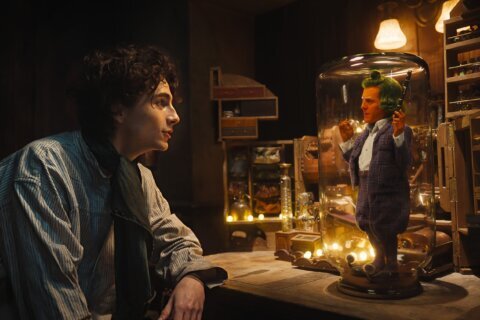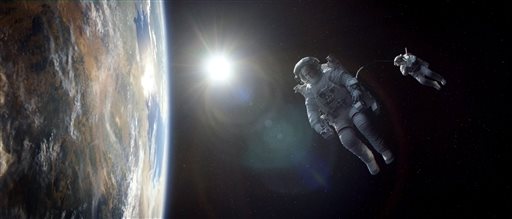
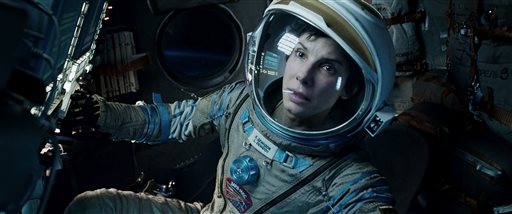
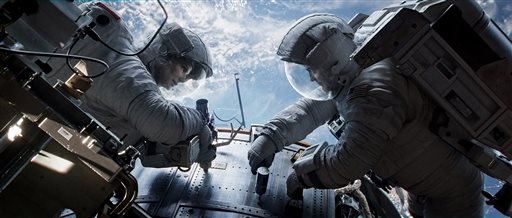
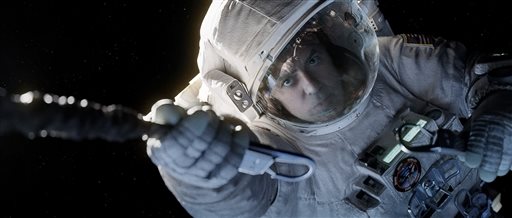
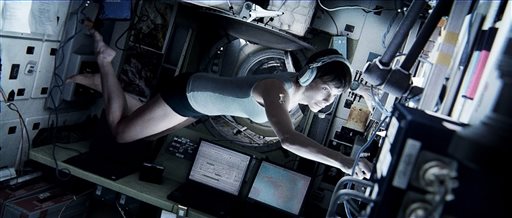
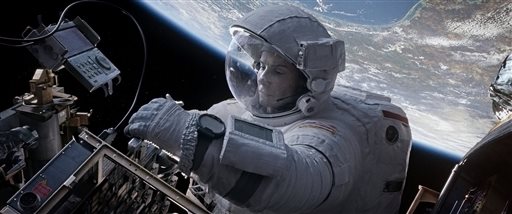
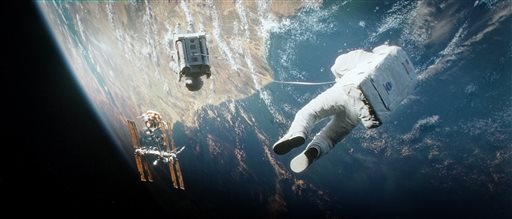
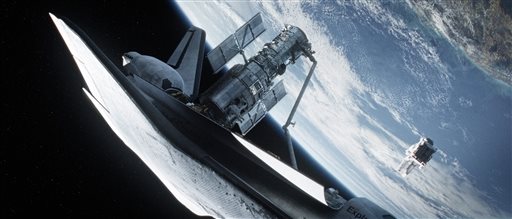
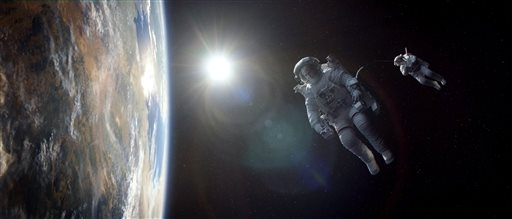
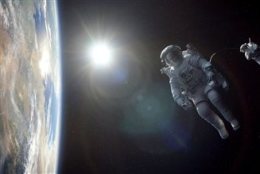
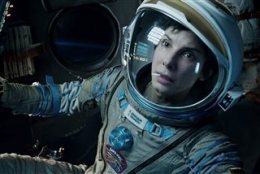
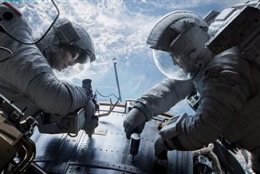
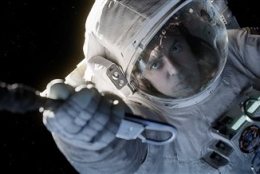
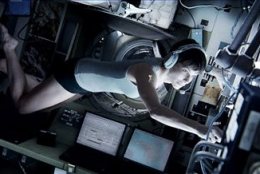
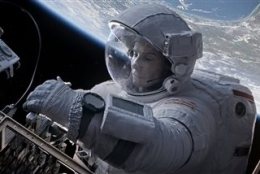
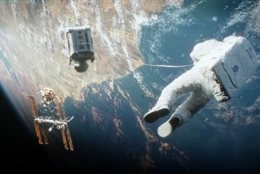
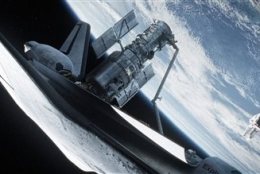
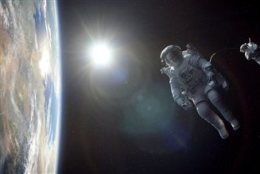
WASHINGTON – It took 12 years longer than Stanley Kubrick predicted, but ladies and gentlemen, welcome to “2013: A Space Odyssey.”
In an age of binge-watching on tiny mobile screens, writer/director Alfonso Cuaron just made the year’s best case for still seeing movies on the big screen.
That is to say, you’re cheating yourself if you don’t see “Gravity” in 3D/IMAX, two formats that were once gimmick enhancements, but which are now suddenly crucial parts of the viewing experience.
The film follows biomedical engineer Ryan Stone (Sandra Bullock) on her first NASA mission, working in space with experienced astronaut Matt Kowalski (George Clooney), who helps her find her space legs and overcome the grief of losing a child.
The routine space mission takes a major turn when Mission Control (voiced by Ed Harris) warns that a Russian satellite has exploded, sending debris toward their ship, the Space Shuttle Explorer.
The advice comes a little too late, as the debris wrecks the shuttle and sends Stone hurtling into space with a torn tether cord and rapidly depleting oxygen. Can Kowalski save her? And will the two ever make it back to Earth? These life-or-death questions are answered in the most exhilarating, realistic special effects we’ve seen in years.
“Gravity” proves that a quality piece of filmmaking can still be made from a popcorn disaster flick in just 90 minutes. Characters routinely remind us of the runtime by setting their wristwatches to 90 minutes, the time it supposedly takes for the debris to orbit Earth and smack them again. This may be far-fetched, scientifically speaking, but it works as a suspenseful internal clock device. It also provides a necessary comfort to viewers who worry they’ll have a panic attack if the film lasts much longer. I dare you to sit through “Oblivion,” “Elysium,” “After Earth” and “Pacific Rim” after watching “Gravity,” which puts those summer sci-fi flops to shame while boasting equally big stars.
Oscar-winner George Clooney (“Syriana”) provides a likable comic relief, while four-time Oscar nominee Ed Harris contributes in straight voiceover after delivering the two best space performances of the last 30 years as John Glenn in “The Right Stuff” (1983) and Gene Kranz in “Apollo 13” (1995).
But make no mistake about it. “Gravity” belongs to Sandra Bullock, who also scored the summer’s hit comedy “The Heat” (2013). This time, the Oscar-winning “Blind Side” actress sends “in the blind” transmissions from her claustrophobic spacesuit and delivers panicked breathing that will make viewers hyperventilate. Bullock flips our expectations, appearing like another “damsel in distress,” but actually giving us a heroic feminist journey that will draw instant comparisons to Sigourney Weaver’s Ellen Ripley in “Alien” (1979), voted the American Film Institute’s No. 8 Hero of All Time.
In the final shot, the culmination of this 90-minute “gender role” transformation, I was reminded of a recent quote by Joss Whedon (“The Avengers”), who was asked why he writes so many “strong female characters.” He responded, “Because you keep asking me that question. … Equality is like gravity. We need it to stand on this earth as men and women. And the misogyny that is in every culture is not a true part of the human condition. It is life out of balance.”
Perhaps it’s fitting, then, that “Gravity” comes after Bullock’s highly-publicized divorce and subsequent adoption of her son. In the film, Clooney calls Bullock out for secretly enjoying being lost in space because it’s away from all the pain of earthly life, including the loss of her child. The parent-child theme may very well stem from the fact that Cuaron co-wrote the script with his own son, Jonas Cuaron. The “grieving parent” character need is often overused, but it worked for me here, knowing the connections to Bullock’s and Cuaron’s own real-life stories. It also provided just enough backstory on which to hang the dazzling visuals and evolutionary themes (see below).
Bullock’s scrappy survival tale may seem narratively simpler than “2001: A Space Odyssey” (1968), which ambitiously sought the meaning of life through four Monolith markers of mankind’s enlightenment. The “Gravity” characters could also be developed more, but they’re no less developed than Dave Bowman (Keir Dullea) in “2001,” where HAL 9000 was far more compelling than any of the astronauts. In many ways, “Gravity” functions as a sort of thematic inverse of “Space Odyssey.”
While Kubrick began on Earth with the “origin of the species” and moved outwardly toward the far reaches of space, Cuaron starts in space and moves inwardly in a quest back to Earth. As she gets closer to Earth, she gets increasingly more primal, communicating with Chinese astronauts by howling like a wolf, a sort of reverse Darwinism to Kubrick’s apes, all the way until the final shot where Bullock emerges out of the water, like a sea-creature evolved, standing with the gravity of reborn human legs.
However, Cuaron isn’t all science. In the very same scene that she howls like a wolf, Bullock also pleads with God, saying she was never taught how to pray. Cuaron is no stranger to religious themes; “Children of Men” was based on immaculate conception. In “Gravity,” the duality of science and faith is consistent with the awe- inspiring views of looking at Earth from above.
Once this journey is complete, and Bullock emerges from the water, compare it to the evolutionary scene from “The Tree of Life” (2011). Both films use cinematographer Emmanuel Lubezki, who worked with Cuaron on ” Y Tu Mama Tambien” (2001) and “Children of Men” (2006). Lubezki has been nominated for five Oscars, but has gone home empty handed every time. This time could be the ticket.
Still, the most crucial piece is Cuaron, whose involvement generated serious buzz from both critics who loved “Children of Men” and popcorn fans who loved “Harry Potter and the Prisoner of Azkaban” (2004). The film opened at the 70th Venice International Film Festival in August, and this weekend, fans will see for themselves that Cuaron has truly outdone himself with “Gravity.”
He opens the film with a mesmerizing single-take, hovering above Earth as the characters — and catalyst — unfold in real-time. Once the chaos begins, the camera seamlessly moves in and out of Bullock’s helmet in a series of breathtaking POV shots that provide the closest experience to actually being in a space suit that movies can provide. The pacing builds a palpable dread, as Cuaron throws in a few jump scares that will remind you of Spielberg’s “Jaws” (1975) and “Saving Private Ryan” (1998). Elevating all of it are the transcendent score by Steven Price and the jaw-dropping visual effects by Tim Webber, a modern day Douglas Trumbull. Go ahead and give him the Oscar now.
Perhaps most impressive is Cuaron’s ability to push the limits of 3D. The big knock on the technology is its use as a mere visual gimmick. Cuaron does this, for sure, sending Clooney and Bullock reaching for screws that float toward our faces. But he also takes it a step further, tying the 3D graphics to the film’s emotional core by sending Bullock’s 3D tear drops floating toward our own glassy eyes.
History will remember this film as part of 3D’s Mount Rushmore: James Cameron (“Avatar”), Martin Scorsese (“Hugo”), Ang Lee (“Life of Pi”) and Alfonso Cuaron (“Gravity”). If Cuaron pulls off a Best Director Oscar this year, it would mark back-to-back wins for 3D films after Lee’s win for “Life of Pi” (2012). And if “Gravity” somehow makes a Best Picture push and becomes the first 3D/IMAX flick ever to win the Academy’s top prize, we’ll be in a brave new world of cinema.
“Gravity” is one small step for man, but one giant leap for the movies.
★ ★ ★ ★
The above rating is based on a 4-star scale. See where this film ranks in Jason’s 2013 Movie Guide. Follow WTOP Film Critic Jason Fraley on Twitter @AboveTheJFray, read his blog The Film Spectrum or listen Friday mornings on 103.5 FM.
Follow @WTOP on Twitter.



